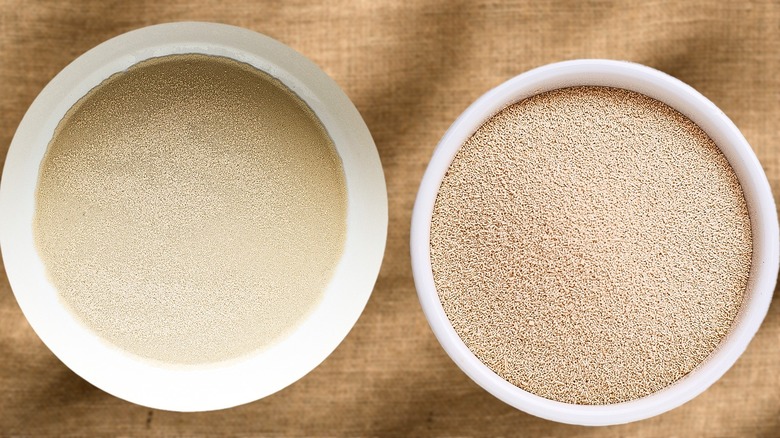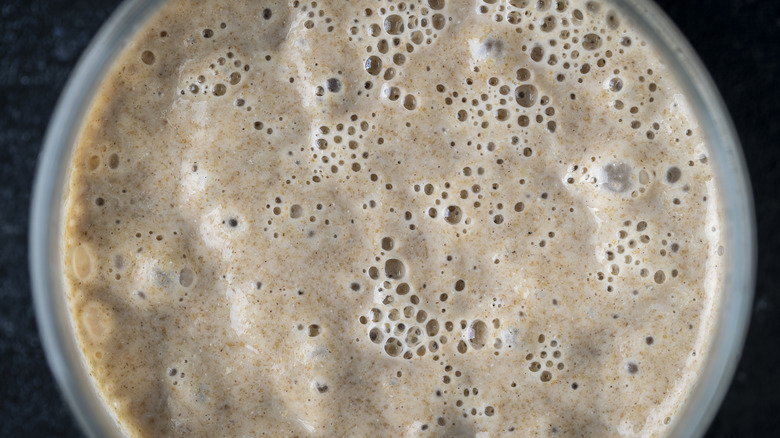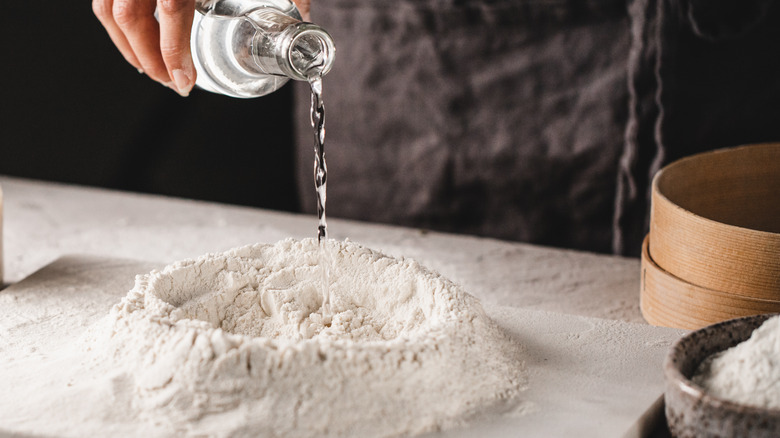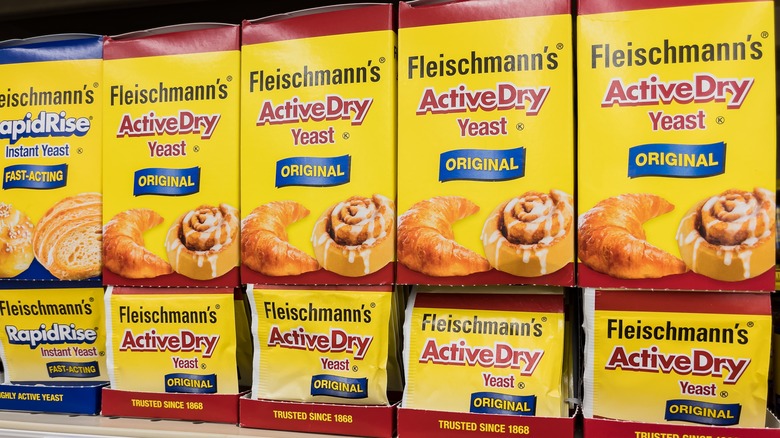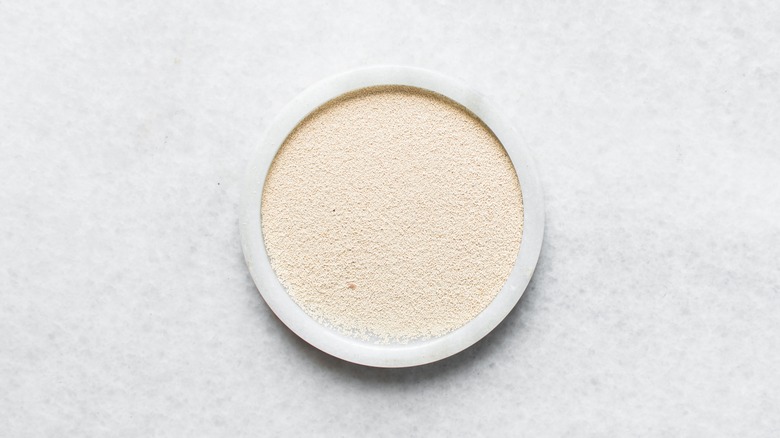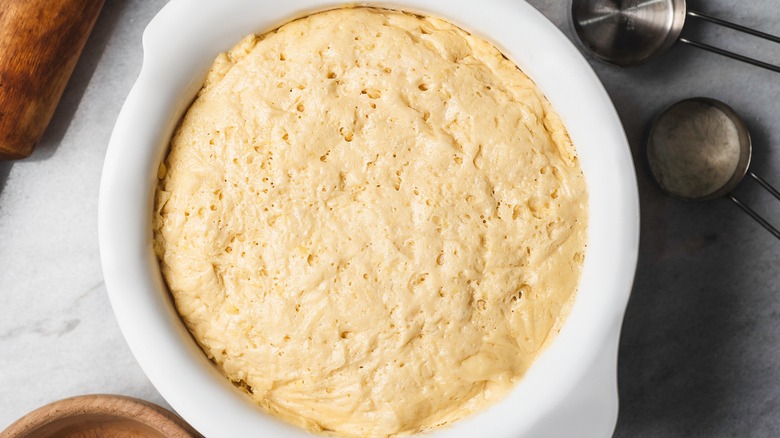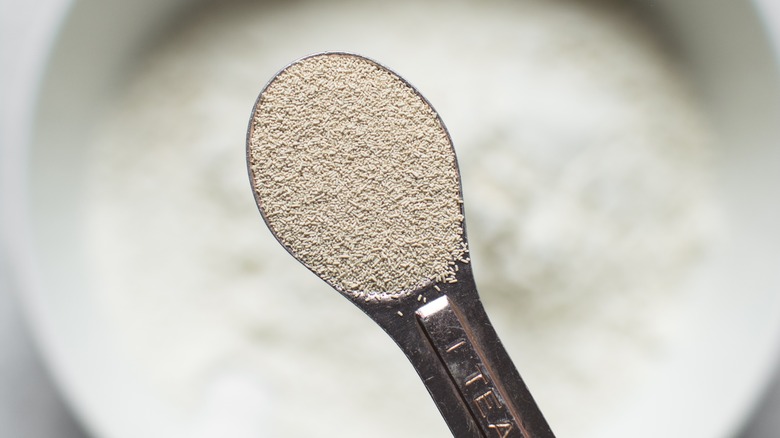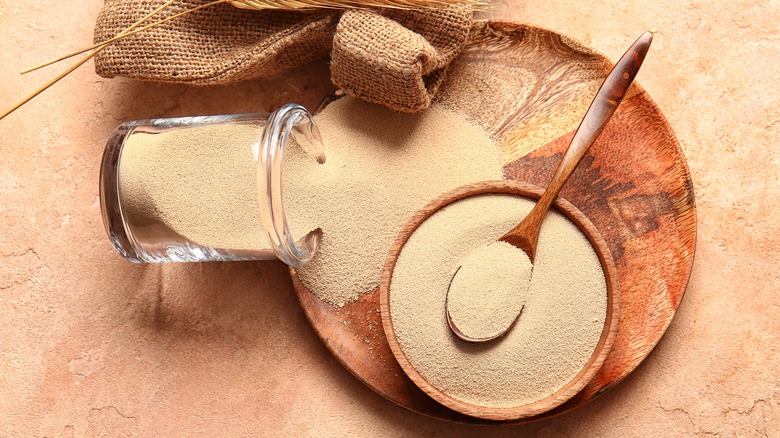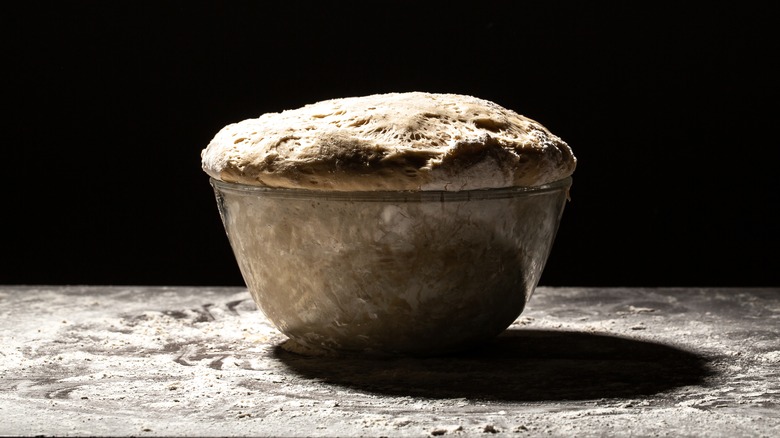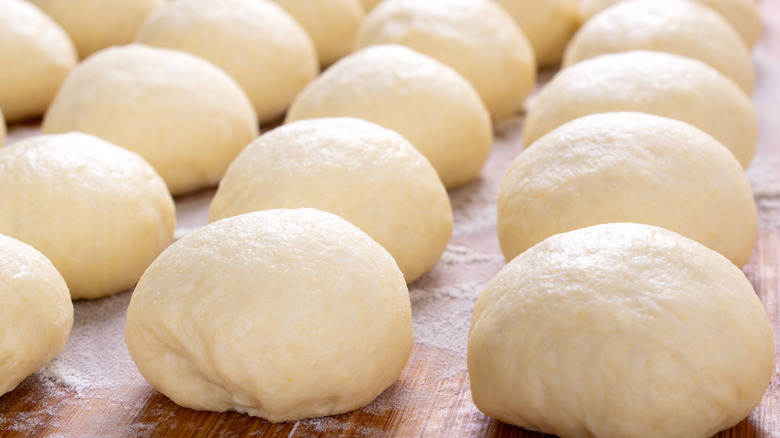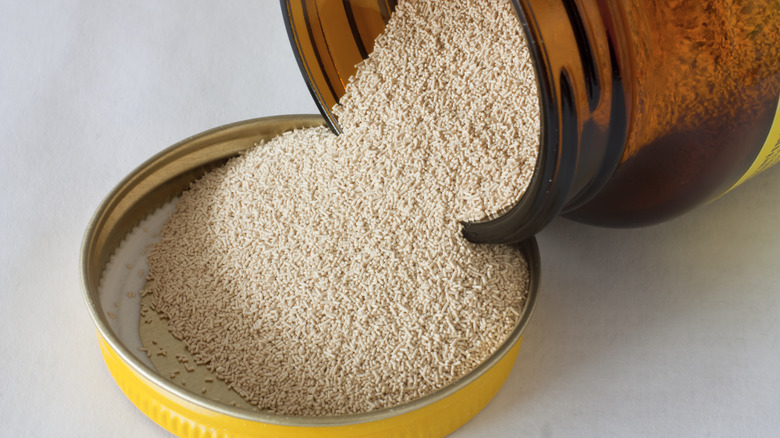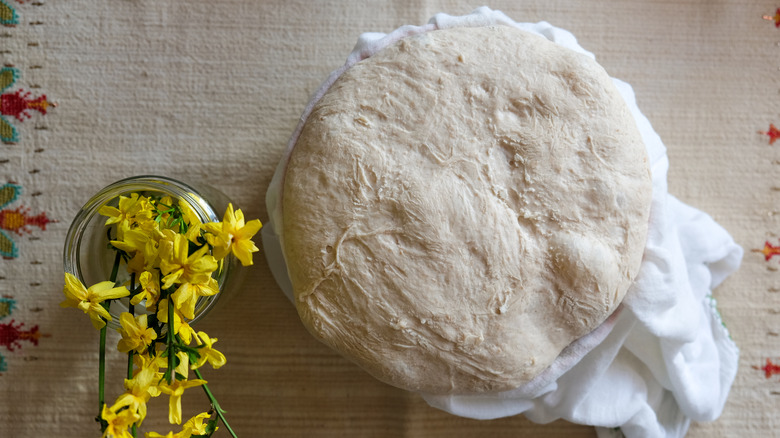Instant Yeast Vs Active Dry Yeast: Everything You Need To Know
Learning to bake with yeast is tough enough, but then the baking world throws other curveballs your way — like the variety of yeasts available. You find yourself standing in supermarket aisles, baffled by which to buy. The two most common options in grocery stores are instant yeast and active dry yeast, so you might be wondering what the difference is between them. As a novice bread baker, this can be confusing and lead to some subpar loaves and other yeasted bakes.
Once you learn more about active dry yeast versus instant yeast, you unlock the secrets to perfectly fluffy cinnamon rolls and sweet, rich brioche, so it's worth spending time to figure out the nuances. I'm a keen baker who used to run a vegan pizza stall, making enough dough to whip up hundreds of pies a day, so I'm well-versed in the ways of yeast.
Instant and active dry yeast are similar, but there are important differences to how you use and store them. If you use them interchangeably, you often won't get the results that you're coveting. For instance, instant yeast can be mixed right into a recipe with your other ingredients, while active dry yeast has to be proofed first. Skip this step and your dough may not rise, which is a waste of time and ingredients. We're about to delve into the differences between instant yeast and active dry yeast to help you up your baking game.
You have to proof active dry yeast before using it
Before adding active dry yeast to a recipe, you should always proof it to make it easier to incorporate into recipes and to make sure it's still alive. Yeast is a single-celled organism that's technically a fungus. Yeast feeds on sugars and produces carbon dioxide while doing so. In baking, the carbon dioxide from the yeast gets trapped in the dough, forming air bubbles and causing the dough to rise. So, if a package of yeast is dead, it won't eat sugars and produce carbon dioxide, and the dough won't rise.
Active dry yeast has more of a tendency to fail than instant yeast, which is more stable, and this is why proofing is recommended. Otherwise you might go to the trouble of mixing and kneading dough only to find that it stays tragically flat.
You might be wondering how to proof yeast. Basically, it involves mixing it in a container with some of the water (or other liquid) from the recipe and a little sugar. The liquid should be lukewarm — too cold and it will take a while for the yeast to proof and you might wrongly assume it's dead, too hot and you'll kill the yeast. It should take around 5 to 15 minutes for the yeast to bubble, at which point you can use it in your recipe. If you don't see any activity, you probably need to buy fresh yeast, or try another packet.
Instant yeast can be mixed right into your recipe
While you have to proof active dry yeast and wait to see if it's still up to the job, the beauty of instant yeast is that you can just mix it into your recipe with the dry ingredients. This saves time and effort. It makes baking simpler and more accessible, especially for those just starting to work with yeast.
The reason for this is that instant yeast dissolves into recipes more easily and is generally more reliable. Assuming it hasn't expired and you've stored it correctly, you can basically assume that it's still alive and won't fail on you. Its ease of use makes it my go-to yeast for pizza-making, bread-making, and other yeasted doughs. And, it's a firm favorite with many other home bakers.
That said, it is worth noting that some people still suggest proofing instant yeast before using it. The folks who recommend this are in the minority, however. It's often suggested as a just-in-case measure to check yeast is still fresh rather than an essential step of the baking process. I've never proofed instant yeast and have had no problems with it.
Active dry yeast has been around for longer
The truth behind yeast is that it's been used in baking and brewing for thousands of years, but it's been available commercially for a much shorter period. If you're wondering about the history of instant yeast versus active dry yeast, the latter has been around for longer. Fleischmann's first launched an active dry yeast product in the 1940s. Prior to this, people would have either used sourdough starters or made bread using fresh yeast (also known as compressed yeast), which has been sold since the 1700s. While many people love the results that fresh yeast gives, it's trickier to work with, doesn't last long, and needs to be kept in the fridge. So, the invention of active dry yeast was a game-changer.
It wasn't until the 1970s that LeSaffre started to sell instant yeast, aiming to further simplify bread baking. So, it's a newer product and was developed as an improvement to the active dry variety. While many people are still happy to use active dry yeast, in some cases it may be because it's what they're used to. They may have started baking before the invention of instant yeast or learned to bake from a parent who hadn't yet adopted this newer style of yeast.
Instant yeast tends to last longer
One of the benefits of instant yeast that make it an increasingly popular choice is that it lasts longer than active dry yeast. Instant yeast has a longer shelf life than active dry yeast. So, if you're going to buy active dry yeast, it's always a good idea to check the expiration date before you hand over your money. It's not unheard of for this type of yeast to die before its listed expiry date (hence the need to proof it), meaning it may have a shorter lifespan than you first thought. Once opened, it won't last more than three to four months in the fridge, so if you don't use it regularly, buy it in packs of individual sachets.
Instant yeast not only has a longer shelf life in general, but also lasts longer once the air hits it. I've stored it in the fridge for over a year with little notable loss of leavening power. You can also store it in the freezer where it may last for over 2 years. You can even throw it in recipes frozen, straight from the freezer. There are many mistakes people make when baking bread, but using yeast that's past its best doesn't have to be one of them, as long as you know how to store yeast properly.
Active dry yeast prefers cooler temperatures
One of the important factors when it comes to choosing the right type of yeast is considering its temperature requirements. Active dry yeast is best kept at cool temperatures. Once you get it home, you should store it in a cool pantry or cabinet or even in the fridge, especially if your kitchen is often on the warm side. Instant yeast is a little more tolerant of warmer temperatures. While it's not ideal to keep it somewhere very warm, it'll be fine even at a higher room temperature when unopened — though it should go in the fridge or freezer once opened.
There's also the question of what temperature you should proof it at. Active dry yeast can be damaged by temperatures of over 115 F, while instant yeast can deal with slightly higher temperatures of up to 130 F. Bread doughs rise perfectly well with cooler water, it just takes them a little longer to do so. However, when you use too-hot water, you risk killing the yeast and ruining your recipes. So it's best to err on the side of caution.
People often describe the ideal temperature for the liquids in yeasted doughs as "lukewarm," but who really knows what this means? Misinterpretation can lead home bakers to use overly warm water and cause their recipes to fail. Instead, think of the ideal water temperature as tepid. If you stick a finger in, it shouldn't feel much warmer than your body temperature.
You need less instant yeast
It seems safe to assume that you could simply switch instant yeast for active dry yeast — or vice versa — in a recipe, adding or taking away the yeast proofing step, as necessary. But, it's not that straightforward. There's actually a difference in the amount of each yeast you need to use in a recipe, so it's important to make the necessary adjustments.
You need less instant yeast than active dry yeast - about ¾ of the quantity — to get the same results. This is because the fermentation process is faster with instant yeast than its active dry cousin. So, if you want to substitute one of these yeasts for the other in a recipe, you'll need to do a bit of math. For every teaspoon of active dry yeast in a recipe, use ¾ teaspoon of instant yeast. Or, for every teaspoon of instant yeast, use 1 ¼ teaspoons of active dry yeast.
Alternatively, you could keep the yeast quantities the same but adjust the fermentation period. So, if a recipe calls for instant yeast and you use active dry, the dough might need an extra 10 to 15 minutes added to its proofing time. Or, if a recipe calls for active dry yeast and you use instant, you could shave 10 to 15 minutes off the dough's proofing time.
Active dry yeast tends to cost more
On average, active dry yeast is a little more expensive than instant yeast, but there isn't much in it. For instance, a pound of active dry may be around a dollar more than a pound of instant yeast. But, this can vary between brands and stores. Sometimes instant yeast and active dry yeast from the same brand cost the same amount of money. And, you'll always pay more for high-end instant yeast compared to basic active dry yeast.
However, when considering cost, you should also take into account how much yeast you're going to use. As we mentioned above, you only need around ¾ of the amount of instant yeast in a recipe compared to active dry. So, the same quantity of instant and active dry might cost the same amount at times, but the instant yeast will go further, meaning you get better value. This might leave you wondering why people pay more for active dry yeast when it does the same job as instant yeast, but maybe a little bit worse. Well, we're pondering the same thing.
Instant yeast works faster and gives you a bigger rise
Looking to cut down on rising time slightly? Then you should know that instant yeast works faster than active dry. It gets to work quickly and starts rising right away, while active dry gets started more slowly. When you also factor in the extra time it takes to proof active dry yeast before adding it to a recipe, instant yeast is the clear winner in the speed stakes. So, should you wish to proof your dough for slightly less time, choose a recipe that calls for active dry yeast and replace it with the same amount of instant yeast — this will cut about 10 minutes off the rising time, plus saving you extra time because you don't have to proof the yeast.
But, it's not just that instant yeast works faster, it actually produces more carbon dioxide overall. This means more bubbles trapped in the dough and a bigger rise. So, if you're often disappointed with the rise you get on your bread and you use active dry yeast, it might be time to switch to instant.
If you want to know if your bread dough is ready to bake, first off, it should have roughly doubled in size. When you think it's ready, lightly press the top of the dough, hard enough to make a slight indent but not so that it deflates the bread. If it's ready to bake, it should spring back quickly, erasing the indent.
Instant yeast and active dry yeast both work for doughs with more than one rise
Some bread recipes only involve a single rise before putting it into the oven. However, many yeasted doughs need to rise twice before baking them. The first rise is often known as the bulk ferment. This is where you let all the ingredients rise in a big bowl after kneading. Following the bulk ferment, you may split the dough into pieces and shape them before a second rise. For instance, when baking pizza for my former business, I would do the bulk ferment in huge containers before dividing the dough into pieces the size of a single pizza. I'd then shape them into balls and let them rise a second time before stretching, topping, and baking.
Now, you might be wondering if instant yeast – with its faster rising time — is suitable for doughs that need more than one rise. Here's the short answer, it is. Both instant and active dry yeasts stay active for long enough to produce plenty of carbon dioxide for two rises. The confusion comes from the other types of yeast that are only good for a single rise. Fast-acting yeast — or rapid rise yeast — only produces enough carbon dioxide for one rise. It works super quickly but then burns itself out. It's sometimes called fast-acting instant yeast, which is why it's easy to muddle it up with regular instant yeast.
Active dry yeast is made of bigger granules
If you have both types of yeast and you aren't sure which is which, you should be able to tell just by comparing the two. Active dry yeast is made up of larger granules than instant dry yeast. The difference is relatively subtle, but noticeable. Active dry is like tiny pellets while instant yeast is more like a coarse powder.
This difference isn't just down to chance. The reason instant yeast is milled finer than active dry is so that it dissolves as soon as it gets wet and starts working more quickly. This is a big part of what makes instant yeast, well ... instant. Because it's so fine, it dissolves into the dough properly even when it's mixed in with the dry ingredients. This means you can skip the yeast proofing step because it doesn't need to be broken down into a liquid to make sure it mixes evenly through the dough. It's a basic distinction and one that most people probably rarely think about, but it makes all the difference to how the yeast performs.
Both instant yeast and active dry yeast should be stored in the fridge or freezer once opened
Every packet of yeast has an expiration date — instant and active dry yeast have that in common — but it might not even make it to this hallowed date if you don't store it correctly. When it's unopened, both types of yeast are fine hanging out in your pantry. But, as soon as you open them, they need to be stored in the fridge or the freezer to keep them fresh for longer.
For both yeasts, keeping them chilled or frozen after opening can extend their lifespan. If you keep them open in a pantry or kitchen cabinet and they get warm or moist, this is likely to kill them — meaning your bread won't rise and everyone will be disappointed. The official line is that they'll last around four months once opened if you store them in the fridge or six months in the freezer. However, there's plenty of colloquial evidence to suggest open instant yeast lasts for around a year in the fridge or two years in the freezer. There may be some loss of potency in this time, but you can still expect a decent rise. If in doubt over whether or not your yeast is still active, proof it before adding it to a recipe. Or, if you use yeast infrequently, it can be better to buy it in individual packets so they can stay unopened for longer.
Both instant yeast and active dry yeast work for doughs with long fermentation
Do you regularly make doughs with longer fermentation times? Then, you might be pleased to know that both instant yeast and active dry yeast work for doughs that rise for long periods. While your average dough recipe might have an initial hour-long bulk ferment and an additional 30 minute second rise, some recipes take days to fully proof.
These long rises are generally cold proofs — this is when they're left to rise in the fridge for long periods to improve the flavor and texture. And, good news, you can use both types of yeast for breads that have a cold fermentation process. We've already explained that hot water can kill the yeast in your cinnamon rolls – and other yeasted bakes — but it has much less of a problem with low temperatures. So, you don't have to worry that long cold ferments will kill off your yeast. Even freezing temperatures won't kill the yeast in your dough.
